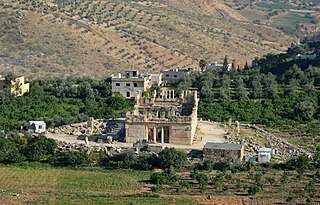The Essenes were a mystic Jewish sect during the Second Temple period that flourished from the 2nd century BCE to the 1st century CE.

The extant manuscripts of the book Antiquities of the Jews, written by the first-century Jewish historian Flavius Josephus around AD 93–94, contain two references to Jesus of Nazareth and one reference to John the Baptist.
Flavius Josephus was a 1st-century Roman–Jewish historian and military leader. Best known for writing The Jewish War, he was born in Jerusalem—then part of the Roman province of Judea—to a father of priestly descent and a mother who claimed royal ancestry.
The Sicarii were a splinter group of the Jewish Zealots who, in the decades preceding Jerusalem's destruction in 70 CE, strongly opposed the Roman occupation of Judea and attempted to expel them and their sympathizers from the area. The Sicarii carried sicae, or small daggers, concealed in their cloaks. At public gatherings, they pulled out these daggers to attack Romans and alleged Roman sympathizers alike, blending into the crowd after the deed to escape detection.
In Greek mythology, Iapetus, also Japetus, is a Titan, the son of Uranus and Gaia and father of Atlas, Prometheus, Epimetheus, and Menoetius. He was also called the father of Buphagus and Anchiale in other sources.

Antiquities of the Jews is a 20-volume historiographical work, written in Greek, by historian Flavius Josephus in the 13th year of the reign of Roman emperor Flavius Domitian which was around CE 93 or 94. Antiquities of the Jews contains an account of the history of the Jewish people for Josephus' gentile patrons. In the first ten volumes, Josephus follows the events of the Hebrew Bible beginning with the creation of Adam and Eve.

The Jewish War or Judean War, also referred to in English as The Wars of the Jews, is a book written by Josephus, a first-century Roman-Jewish historian. It has been described by Steve Mason as "perhaps the most influential non-biblical text of Western history".

The siege of Jerusalem of 70 CE was the decisive event of the First Jewish–Roman War, in which the Roman army led by future emperor Titus besieged Jerusalem, the center of Jewish rebel resistance in the Roman province of Judaea. Following a five-month siege, the Romans destroyed the city and the Second Jewish Temple.
The Ctistae or Ktistai were a group/class among the Mysians of ancient Thracian culture.

Matthew 3:5 is the fifth verse of the third chapter of the Gospel of Matthew in the New Testament. The verse occurs in the section introducing John the Baptist with this verse describing his popularity in the region.
The Life of (Flavius) Josephus, also called the "Life of Flavius Josephus", or simply Vita, is an autobiographical text written by Josephus in approximately 94-99 CE – possibly as an appendix to his Antiquities of the Jews – where the author for the most part re-visits the events of the War, apparently in response to allegations made against him by Justus of Tiberias.

Qasr al-Abd is a large Hellenistic palace from the first quarter of the second century BCE. Most scholars agree it was built by the Tobiads, a notable Jewish family of the Second Temple period, although the descriptions doesn't mention that. Its ruins stand in modern-day Jordan in the valley of Wadi Seer, close to the village of Iraq Al-Amir, approximately 17 kilometers west of Amman.
Gessius Florus was the 7th Roman procurator of Judea from 64 until 66.

Alexandreion (Greek), or Alexandrium (Latin), called Sartaba in the Mishna and Talmud and Qarn Sartaba in Arabic, was an ancient hilltop fortress constructed by the Hasmoneans between Scythopolis and Jerusalem on a pointy barren hill towering over the Jordan Valley from the west. It was likely named after Hasmonean king Alexander Jannæus.
Lucceius Albinus was the 6th Roman Procurator of Judea from 62 until 64 and the governor of Mauretania Tingitana from 64 until 69.

The Slavonic Josephus is an Old East Slavic translation of Flavius Josephus' History of the Jewish War which contains numerous interpolations and omissions that set it apart from all other known versions of Josephus' History. The authenticity of the interpolations was a major subject of controversy in the 20th century, but the latest scholarship has rejected them.

Livias was a city in Transjordan in Classical Antiquity. In the writings of Josephus (English translation), the name is presented as Julias.

'Iraq al-Amir or Araq el-Amir is the name shared by a town and nearby caves, within the municipality of Amman in the Jordan Valley. Located about 15 km southwest of the town of Wadi as-Seer, it has a population of about 6000 people, mostly members of the Abbadi tribe. It is located on hills with high and medium altitude, in an area with many springs and famous for its olive trees and other forest trees.
Laodice was a Queen of an unknown Kingdom in Asia. She lived at the time of the Seleucid king of Syria Antiochus X Eusebes who reigned 95 BC-92 or 88 BC.
Macheras was a Roman general. According to Josephus's Antiquities of the Jews, he was sent by Ventidius to assist Herod the Great with two legions and 1,000 horsemen.









